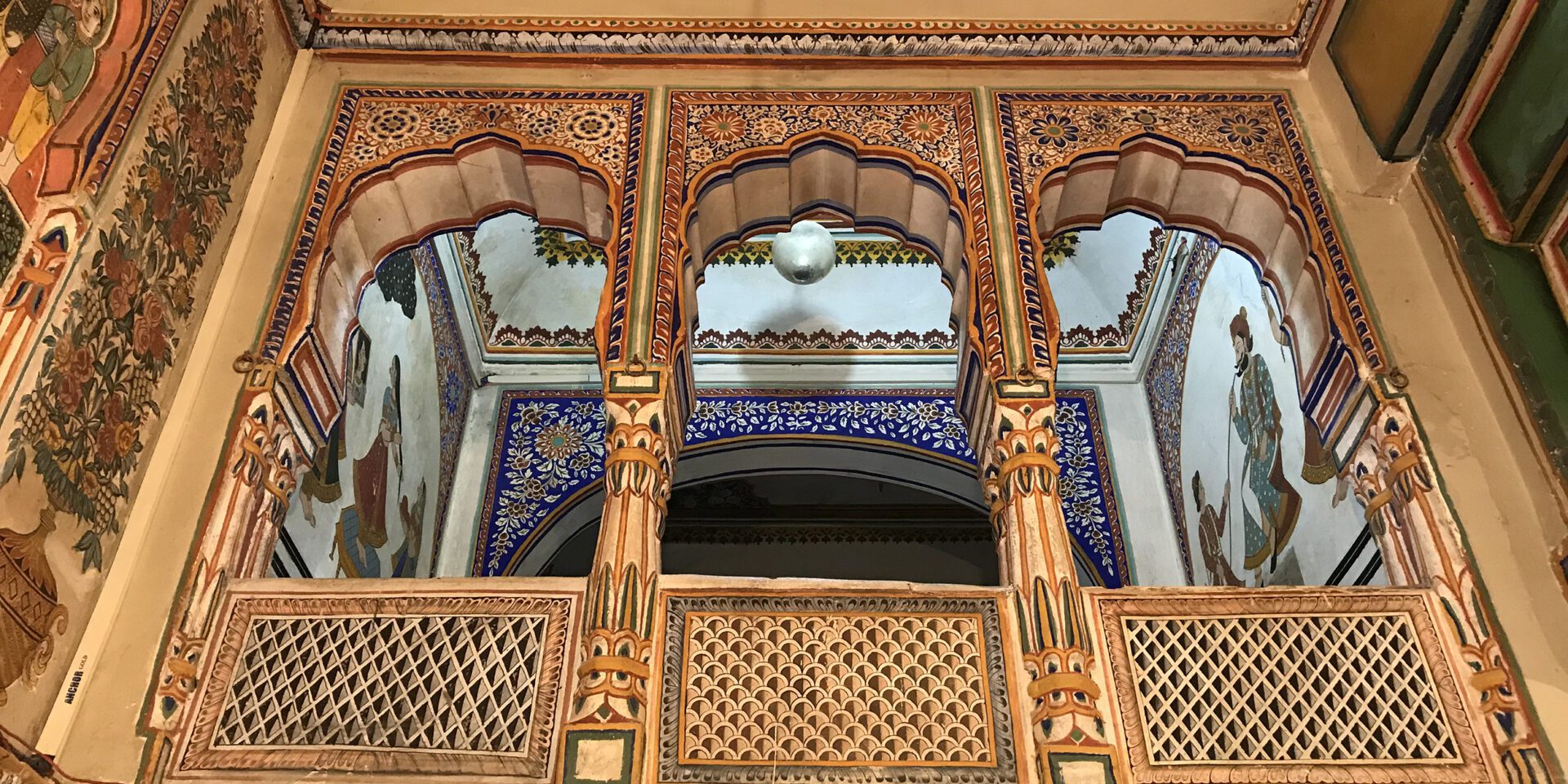Mostly built by Marwari community of Rajasthan, havelis are large mansions adorned with intricate frescos. While havelis are a window into the artistic and cultural heritage of Rajasthan, the havelis in Shekhawati had gone beyond the tradition and cultural heritage. They represent the vivid imagination of wealthy merchants who flaunted their wealth and lifestyle through ornate decorations on the walls of their homes. The early frescos reveal influences from the Mughal art form with the use of filigree and geometric designs; the expressions went overboard later with artists deriving inspiration from royal courts, Victorian lifestyle and art deco influences.
History of Shekhawati
Located on the route of camel caravans, the region of Shekhawati in North Eastern Rajasthan was a bustling trade zone in the early 18th century. The local traders who carried out business with Central Asia and the West saw their fortunes grow with the growth of cotton, spices, silk, and opium trade. These traders ventured into far off lands for business brought back fanciful lavish lifestyle. After returning from their journeys, the wealthy merchants built gigantic mansions in their hometowns. The merchants who also were art patrons commissioned local artisans to paint the walls and interiors with exquisite frescos illustrating not only local cultural and religious customs but also the rendering of fancy elements. The havelis consisting of hundreds of rooms, courtyards, and windows were decorated with Belgian mirrors, Burmese teak wood, Murano glasses and other ostentatious extravaganza brought from the West.
With the beginning of 20th century, the trade shifted; the merchants moved their businesses to port cities of Mumbai and Kolkata. Eventually, they shifted their families as well, leaving behind large empty havelis in the hands of caretakers. Today most of these havelis in Shekhawati are unattended, in ruins, entangled in litigation between multiple ownerships and family feuds.
Havelis in Shekhawati
Havelis were designed using the principles of natural ventilation. Every classic haveli in Shekhawati is a two storey building with large doors, multiple windows and one or more central open courtyards lined with multiple rooms. The open-air courtyards and numerous large and small windows ensured lighting as well as cooling with air circulation caused by temperature differences.
The havelis were primarily occupied by large families with multiple siblings and their children. Each haveli contained anywhere from 20 to 200 rooms. While the outer courtyard was primarily used for merchant’s business gatherings, inner yards were used for household chores. The narrow courtyard behind the main residential complex was used by the serving staff and for animal shelters. Depending on the period during which they were built, most of the haveli facades are an amalgamation of multiple windows, jharokhas, arches overlooking the main streets or bustling bazaars of the town.
Outer Courtyard
The exquisitely carved main entrance door was crafted to welcome guests in the outer courtyard. The walls of the outer courtyard were decorated with Belgian mirrors in such a way that it would brighten up the indoors. The main door was large enough to allow camels inside the outer courtyard to offload the cargo, which would be later auctioned in adjacent rooms. The business dealings were conducted in a large sitting area known as baithak in the outer courtyard. Overhanging large manually operated fan ensured air cooling for the guests. Next to the baithak, there were smaller rooms tucked away behind the main sitting area. These corner rooms were used for private business negotiations. Another corner room was dedicated to munimji (accountants) who would maintain the details of business accounts. Other smaller rooms lining the outer courtyard were meant for the overnight stay for guests who were accompanying the cargo.
During festival times the outer courtyard would be used for hosting ceremonies such as Janmashtami, Ram Navami, for holi celebrations or for weddings and engagements of family members. The women of the house never ventured in the outer courtyard. The galleries hanging over the baithak is where womenfolk of the house gathered to look at the ceremonies through transparent lace curtains.
Inner Courtyard
A large ornate door in the open air outer courtyard led to the inner courtyard, the main residential complex of the haveli. A carving of Ganesha and his wife Siddhi along with other protective deities adorned the entrance door to the inner complex. The inner courtyard is where womenfolk of the house could roam around freely. The open-air courtyard was flanked by a tulsi plant in the center while brass vessels of various sizes occupied different corners. The inner courtyard is flanked by rooms of various sizes which accommodated a master bedroom, a kitchen, rooms for music classes and other activities. All the rooms were covered with intricately carved wooden doors adorned with silver or gold metal platings. All the doors were opaque barring for the ones covering a small room used for water storage. The water storage room in a haveli is covered with a door with holes or grill for cooling. The narrow stair in the inner courtyard led to higher floors of the haveli and to the terrace. Most of the havelis were two storey mansions, with a terrace on top of it. Toilets were situated behind the main courtyards, in a separate area of the house.
Frescos on havelis in Shekhawati
Exquisite frescos consisting of fanciful wall art is what makes havelis in Shekhawati quite unique. The richly ornate havelis of Shekhawati were painted from wall to wall leaving not an inch empty. The vivid frescos were painted using vegetable dyes from local materials of Vermillion, Indigo, Kohl and lime. The seashell powder was used to give shine to wall plasters and murals.
While most of the frescoes depicted myriads of themes from gods, goddesses, Krishna leela, festivals, local customs, and ceremonies; some were highly imaginative work of art illustrating the fancy of haveli owners. The artisans were commissioned to render the exotic which merchants may have seen or experienced during their travels abroad.
It is fascinating to find trains and victorian chariots next to paintings of gods and goddesses. The town dwellers could only imagine the life in far-off lands looking at the visuals on havelis. One can find the juxtaposition of strange objects such as Victorian vases, gramophones, Japanese dolls, sailing cargo, camels and Rolls Royce cars next to mythology-themed murals containing Ram, Sita, Krishna, and Radha. The Jesus and Anarkali can be seen isolated amongst English memsahibs dressed in Victorian costumes. A horse carriage carrying the elf finds a place next to a young English boy on a bicycle. One can see erstwhile rulers and merchants family members in stylized vintage cars next to a portrait of Queen Victoria. Bollywood superstars of yesteryears adorn the walls and ceilings of a haveli next to murals of floral vases and elephants. The most bizarre of all is a fresco of Krishna and Radha romancing sitting on a chair! The frescos seemed to transcend all the boundaries of centuries of timelines.
Interesting facts about havelis in Shekhawati:
– Shekhawati as a region comprises the districts of Jhunjhunu, Nagaur, Sikar, and Churu
– Spread across 100 km, there are more than 2000 havelis in Shekhawati region
– Most of the previous haveli owners Ruias, Kotharis, Poddars, Goenkas, and Murarkas are now famous industrialist families well known across India and the world.
All the havelis in Shekhawati are abandoned by their owners, barring Podal Haveli and Morarka Haveli in Nawalgarh, which have been restored and converted into museums. The properties have been caught up in a maze of legal battles of multiple ownerships, resulting in no attention from any family member. Though all the havelis in Shekhawati haven fallen into ruins and decays, visiting Shekhawati is like a treasure hunt exploring their lost opulence of Marwari merchants!



